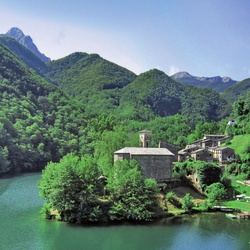The cult of Saint James and the Valle del Serchio
Valle del Serchio. Più vicino a te

In the medieval era, there were three main places of pilgrimage in Christianity: the tomb of Jesus in Jerusalem, the tomb of St Peter in Rome and the place where the remains of the apostle James of Zebedee rested, also known as St James.
According to tradition, a few years after the crucifixion of Jesus, Herod Agrippa I whipped up persecution that led to the beheading of James, making him the first apostle to be martyred. His disciples stole the body and took it to Galicia, where it was buried inside ancient fortifications on Mount Libredón.
Not until 830 was the tomb with the relics found by a hermit called Pelagio, following the miraculous appearance of a star. It contained three bodies, one with a severed head and the inscription “Qui giace Jacobus, figlio di Zebedeo e Salomé” (Here lies Jacobus, son of Zebedee and Salome). Bishop Teodomiro called the place the “Field of the Star” and, in time, the name of the place changed to Santiago de Compostela", a place name combining the name of the Saint with the name of the place where his body was brought.
Here, construction was begun in 1075 of a majestic basilica, also by virtue of the fact that, in the midst of the city’s reconquest, the saint was seen several times on the field of battle in order to strike terror among the Arabs and, at the same time, strengthen the hearts of the Christians.
The pilgrimage to Santiago de Compostela leads to the expiation of sins of varying gravity; for this reason, the cult of the saint spread rapidly along the routes to the sanctuary. The Valle del Serchio was also involved in the transit of pilgrims, since Lucca was one of the main stages both for those en route to Rome and those heading for Galicia.
The first dedicated church was that of San Jacopo di Capraia, a town on the road leading to San Pellegrino in Alpe, of which we have news as early as 1167, when the chapel was listed among the ecclesiastical properties under the parish of Fosciana.
In Gallicano, the Chiesa di San Jacopo was joined to the parish church of San Giovanni and another three chapels of Santa Maria di Pianizza, Sant’Andrea extra muros and Santa Lucia, thereby becoming the town’s parish church. There was also a temple dedicated to the Saint in Crasciana and this was also located in the town, while the ancient parish church of San Frediano, located a few kilometres outside the walls, was in the end joined with this more recently founded structure.
It is also significant that a hospital was built dedicated to St James in Isola Santa, a small residential centre located on the Valdarni road, that served to welcome the pilgrims who travelled along that road so they would not by attacked at night as they walked through the thick woods.
Since the most remote past, Garfagnana was considered a “land of passage” and that is the reason there are many buildings of worship in these lands dedicated to St James, a saint often associated with the routes of pilgrimage.
The cult of St James also sprang up in numerous areas other than those mentioned, towns in which places of prayer named for the apostle were erected and, among these, particular reference is made to those of Pugliano, Capanne di Careggine, Camporgiano, Vallico di Sotto and Borgo a Mozzano.



